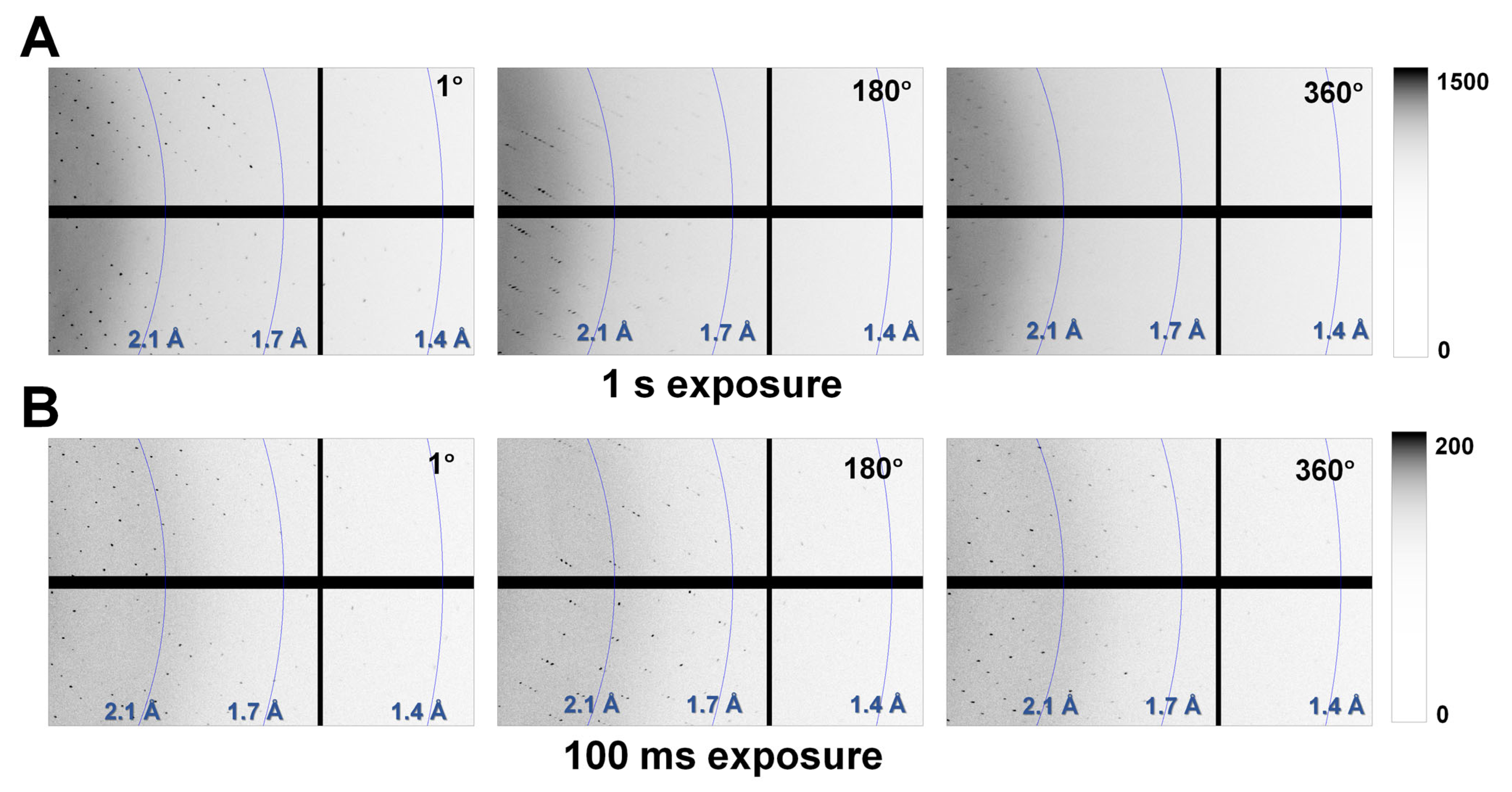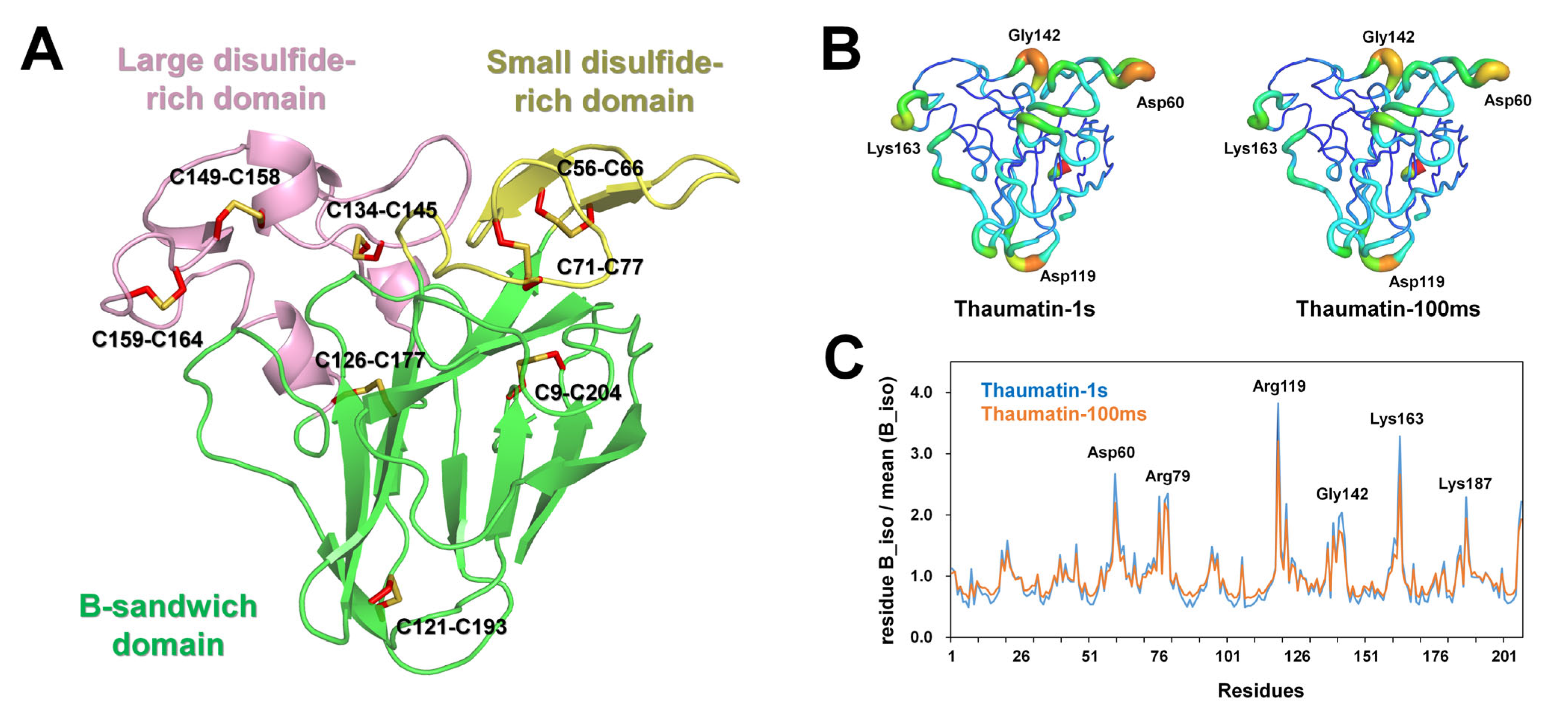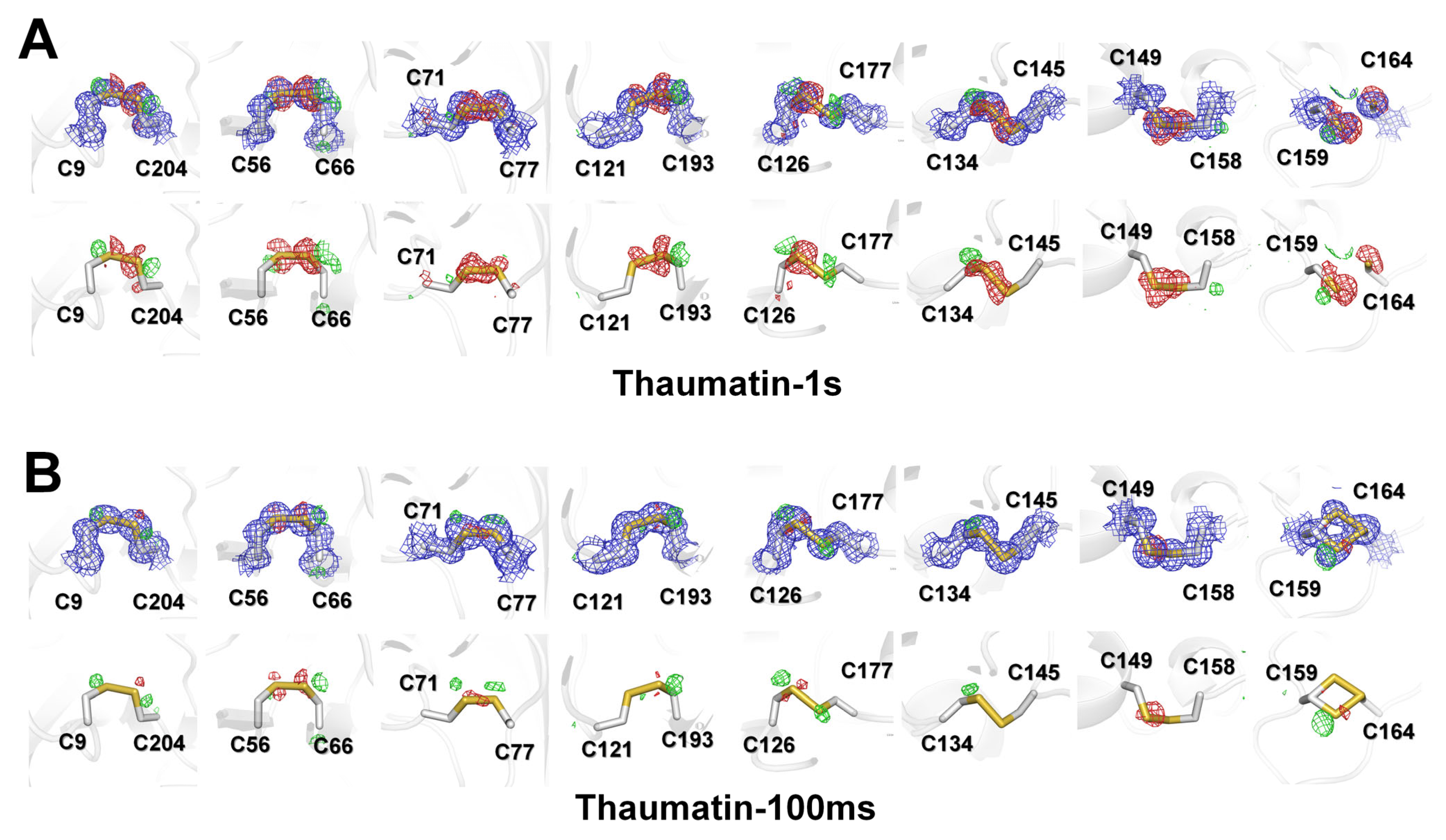Radiation Damage on Thaumatin: A Case Study of Crystals That Are Larger Than the Microfocusing X-ray Beam
Abstract
1. Introduction
2. Materials and Methods
2.1. Crystallization
2.2. Data Collection
2.3. Structure Determination
2.4. Structure Analysis
3. Results
3.1. Data Collection
3.2. Structure Analysis
3.3. Data Dissection
4. Discussion
5. Conclusions
Funding
Institutional Review Board Statement
Informed Consent Statement
Data Availability Statement
Acknowledgments
Conflicts of Interest
References
- McPherson, A.; Gavira, J.A. Introduction to protein crystallization. Acta Crystallogr. F Struct. Biol. Commun. 2013, 70, 2–20. [Google Scholar] [CrossRef] [PubMed]
- Nam, K.H.; Haitjema, C.; Liu, X.; Ding, F.; Wang, H.; DeLisa, M.P.; Ke, A. Cas5d protein processes pre-crRNA and assembles into a cascade-like interference complex in subtype I-C/Dvulg CRISPR-Cas system. Structure 2012, 20, 1574–1584. [Google Scholar] [CrossRef] [PubMed]
- Nam, K.H. Crystal structure of human brain-type fatty acid-binding protein FABP7 complexed with palmitic acid. Acta Crystallogr. D Struct. Biol. 2021, 77, 954–965. [Google Scholar] [CrossRef] [PubMed]
- Nam, K.H. Structural analysis of metal chelation of the metalloproteinase thermolysin by 1,10-phenanthroline. J. Inorg. Biochem. 2021, 215, 111319. [Google Scholar] [CrossRef] [PubMed]
- Zheng, H.; Hou, J.; Zimmerman, M.D.; Wlodawer, A.; Minor, W. The future of crystallography in drug discovery. Expert Opin. Drug Discov. 2013, 9, 125–137. [Google Scholar] [CrossRef]
- Hogg, T.; Hilgenfeld, R. Protein Crystallography in Drug Discovery. In Comprehensive Medicinal Chemistry II; Elsevier Science: Amsterdam, The Netherlands, 2007; pp. 875–900. [Google Scholar]
- Roda, S.; Robles-Martín, A.; Xiang, R.; Kazemi, M.; Guallar, V. Structural-Based Modeling in Protein Engineering. A Must Do. J. Phys. Chem. B 2021, 125, 6491–6500. [Google Scholar] [CrossRef]
- Kuhlman, B.; Bradley, P. Advances in protein structure prediction and design. Nat. Rev. Mol. Cell Biol. 2019, 20, 681–697. [Google Scholar] [CrossRef]
- Shelley, K.L.; Garman, E.F. Quantifying and comparing radiation damage in the Protein Data Bank. Nat. Commun. 2022, 13, 1314. [Google Scholar] [CrossRef]
- Taberman, H. Radiation Damage in Macromolecular Crystallography—An Experimentalist’s View. Crystals 2018, 8, 157. [Google Scholar] [CrossRef]
- Murray, J.; Garman, E. Investigation of possible free-radical scavengers and metrics for radiation damage in protein cryocrystallography. J. Synchrotron Radiat. 2002, 9, 347–354. [Google Scholar] [CrossRef]
- Weik, M.; Ravelli, R.B.G.; Kryger, G.; McSweeney, S.; Raves, M.L.; Harel, M.; Gros, P.; Silman, I.; Kroon, J.; Sussman, J.L. Specific chemical and structural damage to proteins produced by synchrotron radiation. Proc. Natl. Acad. Sci. USA 2000, 97, 623–628. [Google Scholar] [CrossRef] [PubMed]
- Ravelli, R.B.G.; McSweeney, S.M. The ‘fingerprint’ that X-rays can leave on structures. Structure 2000, 8, 315–328. [Google Scholar] [CrossRef] [PubMed]
- Carugo, O.; Carugo, K.D. When X-rays modify the protein structure: Radiation damage at work. Trends Biochem. Sci. 2005, 30, 213–219. [Google Scholar] [CrossRef] [PubMed]
- Weiss, M.S.; Panjikar, S.; Mueller-Dieckmann, C.; Tucker, P.A. On the influence of the incident photon energy on the radiation damage in crystalline biological samples. J. Synchrotron Radiat. 2005, 12, 304–309. [Google Scholar] [CrossRef] [PubMed]
- Corbett, M.C.; Latimer, M.J.; Poulos, T.L.; Sevrioukova, I.F.; Hodgson, K.O.; Hedman, B. Photoreduction of the active site of the metalloprotein putidaredoxin by synchrotron radiation. Acta Crystallogr. D Biol. 2007, 63, 951–960. [Google Scholar] [CrossRef]
- Garman, E.F. Radiation damage in macromolecular crystallography: What is it and why should we care? Acta Crystallogr. D Biol. 2010, 66, 339–351. [Google Scholar] [CrossRef]
- Burmeister, W.P. Structural changes in a cryo-cooled protein crystal owing to radiation damage. Acta Crystallogr. D Biol. 2000, 56, 328–341. [Google Scholar] [CrossRef]
- McCoy, A.J.; Read, R.J. Experimental phasing: Best practice and pitfalls. Acta Crystallogr. D Biol. 2010, 66, 458–469. [Google Scholar] [CrossRef]
- Schmidt, M.; Šrajer, V.; Purwar, N.; Tripathi, S. The kinetic dose limit in room-temperature time-resolved macromolecular crystallography. J. Synchrotron Radiat. 2012, 19, 264–273. [Google Scholar] [CrossRef]
- Matsui, Y.; Sakai, K.; Murakami, M.; Shiro, Y.; Adachi, S.-i.; Okumura, H.; Kouyama, T. Specific Damage Induced by X-ray Radiation and Structural Changes in the Primary Photoreaction of Bacteriorhodopsin. J. Mol. Biol. 2002, 324, 469–481. [Google Scholar] [CrossRef]
- Schulze-Briese, C.; Wagner, A.; Tomizaki, T.; Oetiker, M. Beam-size effects in radiation damage in insulin and thaumatin crystals. J. Synchrotron Radiat. 2005, 12, 261–267. [Google Scholar] [CrossRef] [PubMed]
- Kim, J.; Kim, H.Y.; Park, J.; Kim, S.; Kim, S.; Rah, S.; Lim, J.; Nam, K.H. Focusing X-ray free-electron laser pulses using Kirkpatrick-Baez mirrors at the NCI hutch of the PAL-XFEL. J. Synchrotron Radiat. 2018, 25, 289–292. [Google Scholar] [CrossRef] [PubMed]
- de la Mora, E.; Coquelle, N.; Bury, C.S.; Rosenthal, M.; Holton, J.M.; Carmichael, I.; Garman, E.F.; Burghammer, M.; Colletier, J.-P.; Weik, M. Radiation damage and dose limits in serial synchrotron crystallography at cryo- and room temperatures. Proc. Natl. Acad. Sci. USA 2020, 117, 4142–4151. [Google Scholar] [CrossRef] [PubMed]
- Kim, J.; Nam, K.H. X-ray-Induced Heating in the Vicinity of the X-ray Interaction Point. Appl. Sci. 2023, 13, 717. [Google Scholar] [CrossRef]
- Sliz, P.; Harrison, S.C.; Rosenbaum, G. How does Radiation Damage in Protein Crystals Depend on X-Ray Dose? Structure 2003, 11, 13–19. [Google Scholar] [CrossRef] [PubMed]
- Warkentin, M.; Hopkins, J.B.; Badeau, R.; Mulichak, A.M.; Keefe, L.J.; Thorne, R.E. Global radiation damage: Temperature dependence, time dependence and how to outrun it. J. Synchrotron Radiat. 2013, 20, 7–13. [Google Scholar] [CrossRef]
- Watenpaugh, K.D. Macromolecular crystallography at cryogenic temperatures. Curr. Opin. Struc. Biol. 1991, 1, 1012–1015. [Google Scholar] [CrossRef]
- Lee, K.; Lee, D.; Baek, S.; Kim, J.; Park, J.; Lee, S.J.; Park, S.; Kim, J.; Lee, J.-L.; Chung, W.K.; et al. Radiation Damage of Polydimethylsiloxane and Polyimide by X-ray Free-Electron Laser. Appl. Sci. 2022, 12, 8431. [Google Scholar] [CrossRef]
- Ogata, C.M.; Gordon, P.F.; de Vos, A.M.; Kim, S.-H. Crystal structure of a sweet tasting protein thaumatin I, at 1·65 Å resolution. J. Mol. Biol. 1992, 228, 893–908. [Google Scholar] [CrossRef]
- Nass, K.; Gorel, A.; Abdullah, M.M.; Martin, A.V.; Kloos, M.; Marinelli, A.; Aquila, A.; Barends, T.R.M.; Decker, F.-J.; Bruce Doak, R.; et al. Structural dynamics in proteins induced by and probed with X-ray free-electron laser pulses. Nat. Commun. 2020, 11, 1814. [Google Scholar] [CrossRef] [PubMed]
- Russi, S.; González, A.; Kenner, L.R.; Keedy, D.A.; Fraser, J.S.; van den Bedem, H. Conformational variation of proteins at room temperature is not dominated by radiation damage. J. Synchrotron Radiat. 2017, 24, 73–82. [Google Scholar] [CrossRef] [PubMed]
- Yamamoto, M.; Hirata, K.; Yamashita, K.; Hasegawa, K.; Ueno, G.; Ago, H.; Kumasaka, T. Protein microcrystallography using synchrotron radiation. IUCrJ 2017, 4, 529–539. [Google Scholar] [CrossRef] [PubMed]
- Winter, G. xia2: An expert system for macromolecular crystallography data reduction. J. Appl. Crystallogr. 2009, 43, 186–190. [Google Scholar] [CrossRef]
- Evans, P.R.; Murshudov, G.N. How good are my data and what is the resolution? Acta Crystallogr. D Biol. 2013, 69, 1204–1214. [Google Scholar] [CrossRef]
- Vagin, A.; Teplyakov, A. Molecular replacement with MOLREP. Acta Crystallogr. D Biol. Crystallogr. 2010, 66, 22–25. [Google Scholar] [CrossRef] [PubMed]
- Masuda, T.; Okubo, K.; Murata, K.; Mikami, B.; Sugahara, M.; Suzuki, M.; Temussi, P.A.; Tani, F. Subatomic structure of hyper-sweet thaumatin D21N mutant reveals the importance of flexible conformations for enhanced sweetness. Biochimie 2019, 157, 57–63. [Google Scholar] [CrossRef]
- Emsley, P.; Cowtan, K. Coot: Model-building tools for molecular graphics. Acta Crystallogr. D Biol. Crystallogr. 2004, 60, 2126–2132. [Google Scholar] [CrossRef] [PubMed]
- Murshudov, G.N.; Skubak, P.; Lebedev, A.A.; Pannu, N.S.; Steiner, R.A.; Nicholls, R.A.; Winn, M.D.; Long, F.; Vagin, A.A. REFMAC5 for the refinement of macromolecular crystal structures. Acta Crystallogr. D Biol. Crystallogr. 2011, 67, 355–367. [Google Scholar] [CrossRef]
- Liebschner, D.; Afonine, P.V.; Baker, M.L.; Bunkoczi, G.; Chen, V.B.; Croll, T.I.; Hintze, B.; Hung, L.W.; Jain, S.; McCoy, A.J.; et al. Macromolecular structure determination using X-rays, neutrons and electrons: Recent developments in Phenix. Acta Crystallogr. D Struct. Biol. 2019, 75, 861–877. [Google Scholar] [CrossRef]
- Williams, C.J.; Headd, J.J.; Moriarty, N.W.; Prisant, M.G.; Videau, L.L.; Deis, L.N.; Verma, V.; Keedy, D.A.; Hintze, B.J.; Chen, V.B.; et al. MolProbity: More and better reference data for improved all-atom structure validation. Protein Sci. 2018, 27, 293–315. [Google Scholar] [CrossRef]
- Winn, M.D.; Ballard, C.C.; Cowtan, K.D.; Dodson, E.J.; Emsley, P.; Evans, P.R.; Keegan, R.M.; Krissinel, E.B.; Leslie, A.G.; McCoy, A.; et al. Overview of the CCP4 suite and current developments. Acta Crystallogr. D Biol. Crystallogr. 2011, 67, 235–242. [Google Scholar] [CrossRef] [PubMed]
- Zeldin, O.B.; Gerstel, M.; Garman, E.F. RADDOSE-3D: Time- and space-resolved modelling of dose in macromolecular crystallography. J. Appl. Crystallogr. 2013, 46, 1225–1230. [Google Scholar] [CrossRef]






| Data Collection | Thaumatin1s | Thaumatin100ms |
|---|---|---|
| Wavelength (Å) | 0.97942 | 0.97942 |
| Temperature (K) | 100 | 100 |
| Processed image number | 1–360 | 1–360 |
| Rotation range per image (°) | 1 | 1 |
| Total rotation range (°) | 360 | 360 |
| Exposure time per image (s) | 1 | 0.1 |
| Space group | P41212 | P41212 |
| a, b, c (Å) | 57.898, 57.898, 150.952 | 57.931, 57.931, 150.520 |
| α, β, γ (°) | 90.0, 90.0, 90.0 | 90.0, 90.0, 90.0 |
| Resolution range (Å) | 54.06–1.13 (1.17–1.13) | 45.91–1.13 (1.17–1.13) |
| Total No. of reflections | 2,299,141 (208,169) | 2,350,491 (206,041) |
| No. of unique reflections | 96,842 (9523) | 96,680 (9513) |
| Completeness (%) | 99.96 (99.87) | 99.89 (99.84) |
| Multiplicity | 23.7 (21.9) | 24.3 (21.6) |
| Mean I/sigma(I) | 9.24 (1.48) | 11.37 (1.30) |
| CC1/2 | 0.998 (0.406) | 0.999 (0.647) |
| CC* | 0.999 (0.760) | 1.000 (0.886) |
| Wilson B factor | 8.07 | 11.46 |
| Refinement | Thaumatin1s | Thaumatin100ms |
|---|---|---|
| Resolution range (Å) | 50.0–1.13 (1.17–1.13) | 45.91–1.13 (1.17–1.13) |
| Rwork | 0.1836 (0.3339) | 0.1698 (0.3541) |
| Rfree | 0.1924 (0.3504) | 0.1805 (0.3558) |
| CC (work) | 0.962 (0.739) | 0.971 (0.810) |
| CC (free) | 0.965 (0.690) | 0.957 (0.830) |
| No. of non-H atoms | ||
| Protein | 1583 | 1583 |
| Ligand | 34 | 34 |
| Water | 315 | 332 |
| R.m.s. deviations | ||
| Bonds (Å) | 0.008 | 0.006 |
| Angles (°) | 0.998 | 0.960 |
| Average B factors (Å2) | ||
| Protein | 10.39 | 13.63 |
| Water | 23.80 | 27.01 |
| Other | 14.20 | 15.69 |
| Ramachandran plot | ||
| Most favored (%) | 98.05 | 99.02 |
| Allowed (%) | 1.95 | 0.98 |
| Data Reprocessing | Data I | Data II | Data III | Data III |
|---|---|---|---|---|
| Processed image range (°) | 1–90 | 91–180 | 181–270 | 271–360 |
| Space group | P41212 | P41212 | P41212 | P41212 |
| a, b, c (Å) | 57.95, 57.95, 150.37 | 57.79, 57.79, 150.32 | 57.97, 57.97, 150.60 | 57.85, 57.85, 150.554 |
| α, β, γ (°) | 90, 90, 90 | 90, 90, 90 | 90, 90, 90 | 90, 90, 90 |
| Resolution range (Å) | 40.98–1.15 (1.19–1.15) | 45.82–1.18 (1.22–1.18) | 45.94–1.17 (1.21–1.17) | 45.87–1.26 (1.30–1.26) |
| Total No. of reflections | 561,360 (54,650) | 516,593 (49,690) | 533,885 (51,881) | 430,190 (41,752) |
| No. of unique reflections | 91,682 (9039) | 84,214 (8292) | 87,349 (8625) | 69,635 (6843) |
| Completeness (%) | 99.79 (99.78) | 99.49 (99.89) | 99.78 (99.75) | 99.47 (99.87) |
| Multiplicity | 6.1 (6.0) | 6.1 (6.0) | 6.1 (6.0) | 6.2 (6.1) |
| Mean I/sigma (I) | 7.30 (1.20) | 7.55 (1.29) | 7.27 (1.00) | 7.31 (1.25) |
| CC1/2 | 0.998 (0.624) | 0.997 (0.601) | 0.997 (0.499) | 0.996 (0.561) |
| CC* | 0.999 (0.877) | 0.999 (0.867) | 0.999 (0.816) | 0.999 (0.848) |
| Wilson B factor | 10.60 | 10.42 | 11.92 | 12.00 |
| Refinement | ||||
| Resolution range (Å) | 40.98–1.30 (1.35–1.30) | 45.82–1.30 (1.35–1.30) | 45.94–1.30 (1.35–1.30) | 45.87–1.30 (1.35–1.30) |
| Rwork | 0.1567 (0.2445) | 0.1570 (0.2545) | 0.1603 (0.2634) | 0.1623 (0.2838) |
| Rfree | 0.1733 (0.2104) | 0.1656 (0.2689) | 0.1712 (0.2792) | 0.1686 (0.2978) |
| CC (work) | 0.969 (0.891) | 0.971 (0.876) | 0.970 (0.865) | 0.971 (0.818) |
| CC (free) | 0.952 (0.941) | 0.971 (0.843) | 0.973 (0.869) | 0.966 (0.813) |
| No. of non-H atoms | ||||
| Protein | 1589 | 1589 | 1589 | 1589 |
| Ligand | 34 | 34 | 34 | 34 |
| Water | 332 | 332 | 332 | 332 |
| R.m.s. deviations | ||||
| Bonds (Å) | 0.011 | 0.008 | 0.007 | 0.007 |
| Angles (°) | 1.14 | 1.15 | 0.97 | 0.98 |
| Average B factors (Å2) | 14.25 | 15.30 | 15.73 | 16.36 |
| Protein | 11.85 | 12.89 | 13.27 | 13.92 |
| Water | 25.73 | 26.81 | 27.47 | 28.04 |
| Other | 14.01 | 15.80 | 15.82 | 17.04 |
| Ramachandran plot | ||||
| Most favored (%) | 98.54 | 99.02 | 98.54 | 99.02 |
| Allowed (%) | 1.46 | 0.98 | 1.46 | 0.98 |
Disclaimer/Publisher’s Note: The statements, opinions and data contained in all publications are solely those of the individual author(s) and contributor(s) and not of MDPI and/or the editor(s). MDPI and/or the editor(s) disclaim responsibility for any injury to people or property resulting from any ideas, methods, instructions or products referred to in the content. |
© 2023 by the author. Licensee MDPI, Basel, Switzerland. This article is an open access article distributed under the terms and conditions of the Creative Commons Attribution (CC BY) license (https://creativecommons.org/licenses/by/4.0/).
Share and Cite
Nam, K.H. Radiation Damage on Thaumatin: A Case Study of Crystals That Are Larger Than the Microfocusing X-ray Beam. Appl. Sci. 2023, 13, 1876. https://doi.org/10.3390/app13031876
Nam KH. Radiation Damage on Thaumatin: A Case Study of Crystals That Are Larger Than the Microfocusing X-ray Beam. Applied Sciences. 2023; 13(3):1876. https://doi.org/10.3390/app13031876
Chicago/Turabian StyleNam, Ki Hyun. 2023. "Radiation Damage on Thaumatin: A Case Study of Crystals That Are Larger Than the Microfocusing X-ray Beam" Applied Sciences 13, no. 3: 1876. https://doi.org/10.3390/app13031876
APA StyleNam, K. H. (2023). Radiation Damage on Thaumatin: A Case Study of Crystals That Are Larger Than the Microfocusing X-ray Beam. Applied Sciences, 13(3), 1876. https://doi.org/10.3390/app13031876






